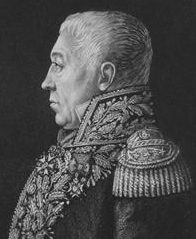General François Louis Dedon-Duclos

Born: October 21, 1762
Place of Birth: Toul, Meurthe-et-Moselle, France
Died: January 19, 1830
Place of Death: Vanves, France
Arc de Triomphe: DEDON on the east pillar
Pronunciation:
The son of a captain in the royal artillery, François Louis Dedon-Nuclos entered the artillery school of Metz in April of 1777. In 1780 he left there as a lieutenant and he was assigned to the artillery regiment of Grenoble, and then in 1787 he was promoted to capitaine. In 1792 Dedon-Duclos joined the Army of the Center and he took command of the 5th Foot Artillery. In the following months he served at the combat before Landau, at the action of Spire, at the action of Mainz, and then before Frankfurt. In 1793 Dedon-Duclos was named directory of artillery at Mainz and that June he was promoted to chef de battalion by the representatives of the people. That July he served under General de Beauharnais at the combats near Landau and then he took command of the artillery during the Siege of Landau. During the siege he was wounded by a shot to the left shoulder during a sortie and then in October he was suspended.
Dedon-Duclos returned to the army in November of 1794, joining the Army of the Rhine. In April of 1795 he was placed in charge of the 1st Battalion of Pontonniers with the army. In June of 1796 Dedon-Duclos was ordered to prepare the crossing of the Rhine at Kehl and then in April of 1797 he facilitated the crossing of the Rhine at Diersheim. Two months later he received a promotion to chef de brigade and he was placed in charge of the corps of pontonniers. In 1797 Dedon-Duclos served as director of artillery at Collioure and then he served under General Augereau in the Army of Germany. Two years later in 1799 he served at the blockade of Ehrenbreistein and then crossing of the Rhine toward Mannheim and he served under Bernadotte at the action of Mannheim. Next Dedon-Duclos joined the Army of Switzerland under General Masséna and that September he fought at the Battle of Zürich where he distinguished himself preparing the crossing of the Limmat at Dietikon. General Masséna promoted Dedon-Duclos on the battlefield due to his contributions to the victory, however, this promotion was not confirmed by the government. In 1800 Dedon-Duclos served in the Army of the Rhine and that May he directed the crossing of the Rhine at Reichlingen where he was wounded in the left wrist.
During the peace that followed, Dedon-Duclos was named chef de brigade of the 7th Foot Artillery. In November of1803 he became the director of artillery at Strasbourg. In 1805 when the Grande Armée marched east to confront the Third Coalition, Dedon-Duclos directed the teams that constructed four bridges over the Rhine for the army to cross. At the end of October he was promoted to général de brigade and then in November he was sent to the Army of the North to command the artillery there. In 1806 Dedon-Duclos was named director general of the artillery parks of the Army of Naples and he served at the Siege of Gaeta as commander of the artillery. As the siege progressed, in June he was wounded in the right leg by the blast of a shell.
In November of 1807 Dedon-Duclos was named a général de division in the service of Naples and he took command of the artillery of the French and Neapolitan Armies in Naples. However, in 1808 he was called to Spain to continue serving Joseph Bonaparte. That year he was rewarded as a Grand Dignitary of the Order of Two Sicilies and a Commander of the Legion of Honor. He served during the Siege of Saragossa and then in March of 1809 he took command of the artillery of III Corps serving in the Army of Aragon. During 1809 Dedon-Duclos went on to serve at the Battle of Talavera and the Battle of Ocaña and then he was named colonel general of the artillery of the King of Spain. In 1810 he served at the crossing of the Sierra Morena and then he took command of the artillery of the Army of the Center. Two years later Dedon-Duclos served during the campaign that led to the Battle of Salamanca, and then he participated in the retreat to Valencia and Madrid. In June of 1813 he fought at the Battle of Vitoria and then the pass of Maya.
Dedon-Duclos was called to Saxony in September of 1813 to join the rest of the Grande Armée fighting there. He took command of the artillery of General Bertrand's IV Corps and in October he served at the Battle of Leipzig and then in the rear guard at the combats of Kösen, Auerstädt, and Hanau. The next month Dedon-Duclos definitively returned to the service of France as a général de brigade and he was placed in charge of the bridging teams of the Grande Armée. He next served at the defense of Mainz until the city was surrendered after Napoleon's abdication in 1814. The restored Bourbons promoted Dedon-Duclos to lieutenant general and named him a Knight of Saint Louis but then retired him. Dedon-Duclos did not actively participate during the Hundred Days of 1815.
Bibliography
- Divry, Arnauld. Les Noms Gravés sur l'Arc de Triomphe. Paris: L'Harmattan, 2017.
- Six, Georges. Dictionnaire Biographique des Généraux & Amiraux Français de la Révolution et de l'Empire (1792-1814). 2 vols. Paris: Gaston Saffroy, 2003.
Updated August 2019
© Nathan D. Jensen